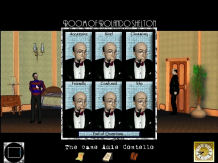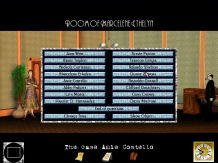Or did he? Maybe it
was the aging actress, or perhaps the gossip columnist was feeling
particularly lethal last night. But on the other hand, perchance the
languid priest has something he needs to confess. But wait, that painter
seems a bit shady to me too. So, who did it? Only you can decide!
What is this
game about?
The Butler Did It
is described by its publisher, Draconus Games, as a “coffee break game”
that you can play in “tens of minutes.” Your character, Jacques-Louis
Barajean, is a celebrated chief inspector with the Paris Police Department
in 1929. Barajean is famous for his almost-psychic ability to ask each
person the correct question in precisely the right tone and with the exact
wording needed to obtain the information he wants. Barajean is
vacationing with his friend, Col Neville Neville at Neville’s hotel in the
Swiss Alps. Looking forward to time of relaxation and renewal, Barajean
instead finds murder!
The Butler Did It
is all about getting to know the large cast of characters and deciding
through deduction and analysis who is telling the truth, who is lying, and
who is guilty. To this end, Barajean investigates with the occasional
assistance of Col Neville and/or the butler, Ursus. He must find physical
clues and interrogate witnesses who may or may not be honest.
Differentiating truth from lies is part of the process. Barajean can, and
sometimes must, choose a different attitude for his interview with each
suspect. The wrong tone results in an uncooperative witness. Once the
investigation is concluded, or once the police arrive—always at 3 pm (very
punctual these Swiss police), Barajean must gather all the suspects
together and point out the guilty party.
Speaking of which,
there are suspects galore! You choose the number of guests—Low Season
finds ten guests at the hotel, Standard season gives you twelve suspects,
and High season yields sixteen. Each guest has a story; Barajean
discovers these stories through interaction with the individual in
question and with other guests. These characters run the gamut from the
outspoken feminist to the slightly over-the-hill movie star. They include
the remorseful war hero and the rascally magician who is starting his own
cult. I learned enough about each character to allow me to lean toward
guilt or innocence, but never enough to be sure of my conclusion. Perhaps
more back story on each character would have facilitated my ability to
correctly solve the case. I never felt I knew sufficient information
about any character to pinpoint a motive for the murder.
What will I do
to solve the murder?
Barajean must observe
the characters’ attire and gather clues about them in order to
successfully introduce himself. Choosing the wrong introductory line from
the eight choices given has the unfortunate result that character refuses
to speak with Barajean until later. He must also choose the correct
manner to use with each person. The correct line culminates in an
interview with that person about the murder, including questions about the
various clues and the other guests. Since there is a time limit in this
game, picking wrongly can become aggravating, so select wisely. The tone
Barajean uses with each person affects how forthcoming they are. Each
guest has something to say about the others. However, often times the
information that is gained conflicts with the information provided by
other suspects. This is also true of information about clues. It is up
to Barajean to sort it all out.
Who will help
me?
Barajean has two
sources of aid in his investigation. The first is Col Neville, who can
open closed doors and move guests from their rooms so Barajean can search
them. Neville can also have Ursus, the butler, move furniture in the
rooms to aid in said search.
Ursus is the second
source of aid to Barajean. He spends most of his time in the butler’s hut
working out in order to pursue his true profession, professional
wrestling! Ursus was with Barajean at the time of the murder so he is
never a suspect. Instead, he is a fount of information about the
background of the guests, and an inspiration to couch potatoes to get
moving.
What
investigative tools will I have?
A great help in the
investigation is a map Barajean obtains from Col Neville. He moves
quickly around the hotel and its environs by clicking on the room he wants
to investigate. In a game with a time limit, time not spent sauntering
around is precious.
In addition, Barajean
carries a notebook which is a really wonderful device. Physical
descriptions of the interviewees are automatically recorded in it
(providing of course, that the inspector examines them) along with any
clues they give him. In it, Barajean notes whether he finds each clue to
be True, False, Irrelevant, or Unknown. This, in turn, affects the list
of suspects in the notebook. Each guest is listed and you can see what
Barajean thinks and how many times he has talked to that guest by clicking
on the name. Very handy little feature, the notebook!
What will I
hear?
The Butler Did It
is mostly a game of words. Sometimes the dialogue is quirky and humorous,
other times it is simply informative, and sometimes it is neither. The
first few times through the game, the dialogue was diverting. But after
that, I only “listened” to the actual interrogations partly because I had
already heard all the dialogue variations and partly to help alleviate the
aggravation of the time pressure. “Listened” because there is no spoken
dialogue. All interaction and dialogue is through subtitles and menu
choices.
I noticed no ambient
sounds except for a clock which sounds the passing of time. I learned
fairly quickly to bypass this by left-clicking. However, there is
background music which changes with each setting and adds a sense of
urgency to the game. I did not find an option to turn it off, or adjust
the volume.
What will I
see?
The graphics are flat
and simple. The hotel provides Barajean with a setting for his
investigation. The opening sequence is reminiscent of an old film reel
with sepia tones and flickering light showing a scratchy series of
pictures and providing background information via text. I enjoyed it.
Characters’ clothing reflects their personality, and may provide a clue to
that important introductory line. Their mouths move when “talking,”
though the rhythm did not seem natural.
How will I move
and save?
This is a true point
and click game. You left click to perform an action. Right clicking
rotates the possible actions between walk, talk, and examine. Inventory
items are automatically picked up once discovered, and the game is Alt+Tab
friendly.
One oddity I noticed
was that my pointer icon stayed as an hourglass until I left-clicked. At
first, I waited and waited for the hourglass to go away and become a
regular icon, but this never happened. I learned to ignore it.
There is a tutorial
accessible from the main menu, and a manual which requires the internet to
read. I know lots of folks skip manuals, but this one contains
information which makes game play lots more fun.
There are no saves.
I’m sure this is because the game is designed to be short, and it is
short. My average game time was thirty-five minutes. Even so, I missed
the ability to save. With several different cases, I had the unfortunate
experience of having life rear its sometimes ugly head after fifteen or
twenty minutes of investigation. I wasn’t ready to solve the case and I
couldn’t save the case, but I had to stop playing and answer life’s call.
Leaving the game open on the computer was not an option, so those cases
just went unsolved. I found this completely frustrating!
I was also bothered
by the lack of a pause button in the first several cases I tried. After
all, the time to solve each case is limited and I did not like having to
leave Barajean on his own watching the time count down while I let the
dogs in or out, answered the phone, etc. Eventually, I discovered that
time only passes in the game if you are doing something—so I could safely
leave Barajean at rest and not be penalized for it. Discovering this made
the game much more enjoyable and less pressured for me.
What is unique
about the game?
The Butler Did It
is a short game designed for replay. The victim and the murderer change
each time you open the game. The dialogue and the music might grow stale,
the clues repetitious, but the basic whodunit will always be fresh.
However, this means there can be no walkthrough nor any hints.
What downsides
did you notice?
I was impressed that
this game is available in several languages including Italian, Finnish,
and English. I played the English version. I noticed several instances
of incorrect word usage, so if that type of thing in on your verboten
list, be forewarned.
I found it difficult
to correctly identify the killer with the clues given. Once the killer
was revealed, I never understood exactly how I should have known his or
her identity. After playing multiple cases, I was no closer to figuring
out the logic of the game than with my first case. I always felt as if I
were missing something. At times, I wondered if correctly naming the
killer called for a lucky guess, or if the clues given were just too
subtle for me to catch.
I also experienced
frustration with the time limit. Trying to choose the correct opening
line and tone, interview the witnesses, and look for clues in the allotted
time was impossible at first. I had to memorize, through repeated games,
which opening line and tone to use with each suspect. In subsequent games
I skipped unnecessary dialogue to give myself more investigative time.
But, even then, I always felt rushed. I think this game would be greatly
improved by eliminating the time limit.
What glitches
did I experience?
This game was stable
on my system. I experienced one crash back to my desktop, but was not
able to repeat it.
What are my
final thoughts about this game?
Playing The Butler
Did It is supposed to be an exercise in deduction and analysis, but I
often felt like it was just a case of rolling the dice. I never
understood the game’s logic and often wondered if the killer was randomly
picked. Still I found myself strangely inclined to try just one more
case, always hoping that the next time I would “get it.” If you can
handle the exasperating timed element, this game can provide an amusing
interlude for those days when you don’t have time for serious gaming, but
would still like to pit your wits against murder most foul.
The Butler Did It
is available by download only at www.draconus.com/games/butler/
Short list:
Point and click
interface
Short game -- less than
an hour per case
Murderer and victim
randomly generated so there is unlimited replay
Alt+tab friendly
Puzzle is one of
deduction—Who is the murderer?
No voice acting, all
subtitles
No saving
Time limit on each case
Simple graphics
Grade: C -
I played on:
Win XP Professional SP1
3.2 GHz Intel Pentium 4
1 GB Dual Channel memory
04-2006
design copyright ©
2006
GameBoomers
Group

